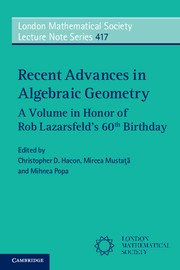Book contents
- Frontmatter
- Contents
- List of contributors
- Preface
- 1 The effect of points fattening in dimension three
- 2 Some remarks on surface moduli and determinants
- 3 Valuation spaces and multiplier ideals on singular varieties
- 4 Line arrangements modeling curves of high degree: Equations, syzygies, and secants
- 5 Rationally connected manifolds and semipositivity of the Ricci curvature
- 6 Subcanonical graded rings which are not Cohen–Macaulay
- 7 Threefold divisorial contractions to singularities of cE type
- 8 Special prime Fano fourfolds of degree 10 and index 2
- 9 Configuration spaces of complex and real spheres
- 10 Twenty points in ℙ3
- 11 The Betti table of a high-degree curve is asymptotically pure
- 12 Partial positivity: Geometry and cohomology of q-ample line bundles
- 13 Generic vanishing fails for singular varieties and in characteristic p > 0
- 14 Deformations of elliptic Calabi–Yau manifolds
- 15 Derived equivalence and non-vanishing loci II
- 16 The automorphism groups of Enriques surfaces covered by symmetric quartic surfaces
- 17 Lower-order asymptotics for Szegö and Toeplitz kernels under Hamiltonian circle actions
- 18 Gaussian maps and generic vanishing I: Subvarieties of abelian varieties
- 19 Torsion points on cohomology support loci: From D-modules to Simpson's theorem
- 20 Rational equivalence of 0-cycles on K3 surfaces and conjectures of Huybrechts and O'Grady
- References
4 - Line arrangements modeling curves of high degree: Equations, syzygies, and secants
Published online by Cambridge University Press: 05 January 2015
- Frontmatter
- Contents
- List of contributors
- Preface
- 1 The effect of points fattening in dimension three
- 2 Some remarks on surface moduli and determinants
- 3 Valuation spaces and multiplier ideals on singular varieties
- 4 Line arrangements modeling curves of high degree: Equations, syzygies, and secants
- 5 Rationally connected manifolds and semipositivity of the Ricci curvature
- 6 Subcanonical graded rings which are not Cohen–Macaulay
- 7 Threefold divisorial contractions to singularities of cE type
- 8 Special prime Fano fourfolds of degree 10 and index 2
- 9 Configuration spaces of complex and real spheres
- 10 Twenty points in ℙ3
- 11 The Betti table of a high-degree curve is asymptotically pure
- 12 Partial positivity: Geometry and cohomology of q-ample line bundles
- 13 Generic vanishing fails for singular varieties and in characteristic p > 0
- 14 Deformations of elliptic Calabi–Yau manifolds
- 15 Derived equivalence and non-vanishing loci II
- 16 The automorphism groups of Enriques surfaces covered by symmetric quartic surfaces
- 17 Lower-order asymptotics for Szegö and Toeplitz kernels under Hamiltonian circle actions
- 18 Gaussian maps and generic vanishing I: Subvarieties of abelian varieties
- 19 Torsion points on cohomology support loci: From D-modules to Simpson's theorem
- 20 Rational equivalence of 0-cycles on K3 surfaces and conjectures of Huybrechts and O'Grady
- References
Summary
Abstract
We study curves consisting of unions of projective lines whose intersections are given by graphs. Under suitable hypotheses on the graph, these so-called graph curves can be embedded in projective space as line arrangements. We discuss property Np for these embeddings and are able to obtain products of linear forms that generate the ideal in certain cases. We also briefly discuss questions regarding the higher-dimensional subspace arrangements obtained by taking the secant varieties of graph curves.
1 Introduction
An arrangement of linear subspaces, or subspace arrangement, is the union of a finite collection of linear subspaces of projective space. In this paper we study arrangements of lines called graph curves with high degree relative to genus. We are particularly interested in the defining equations and syzygies of these subspace arrangements. We will assume an algebraically closed ground field of characteristic zero throughout.
Let G = (V, E) be a simple, connected graph with vertex set V and edge set E. Following [9], we assume that G is subtrivalent, meaning that each vertex has degree at most three. The (abstract) graph curve CG associated with G is constructed by taking the union of {Lυ | υ ∈ V}, where each Lυ is a copy of ℙ1 and lines Lu and Lυ intersect in a node if and only if there is an edge between u and υ in G. (Note that if we think of the nodes of CG as vertices and the lines Lυ as edges, then CG is the graph dual to G.) Since we are assuming that each vertex has degree less than or equal to three, CG is specified by purely combinatorial data; we may assume that on each component of CG the nodes are at 0, 1 or ∞. Note that if each vertex of G is trivalent, then each copy of ℙ1 in CG contains three nodes, and CG is stable (see [4, 9]).
- Type
- Chapter
- Information
- Recent Advances in Algebraic GeometryA Volume in Honor of Rob Lazarsfeld’s 60th Birthday, pp. 52 - 70Publisher: Cambridge University PressPrint publication year: 2015



